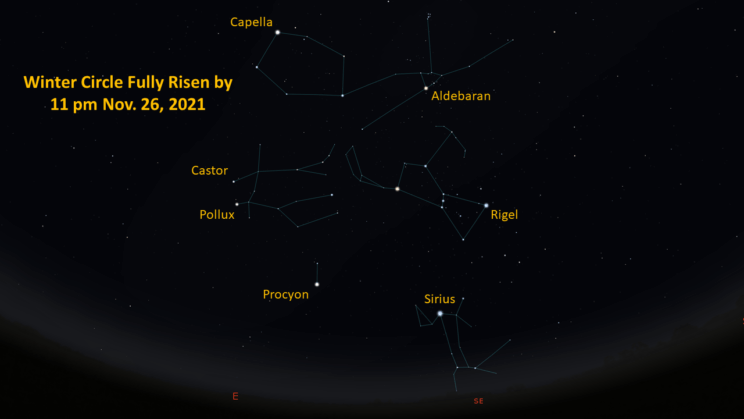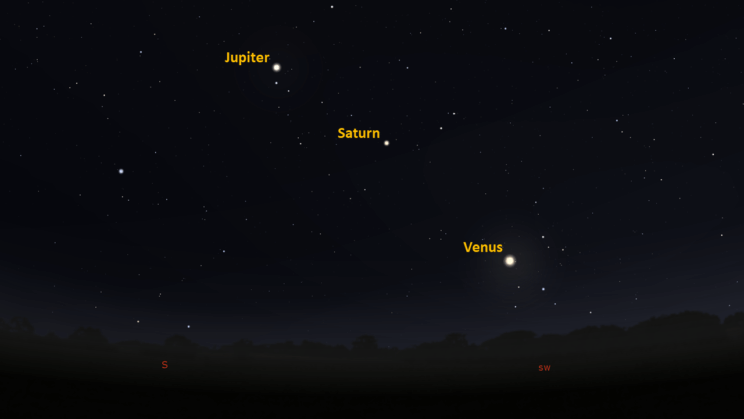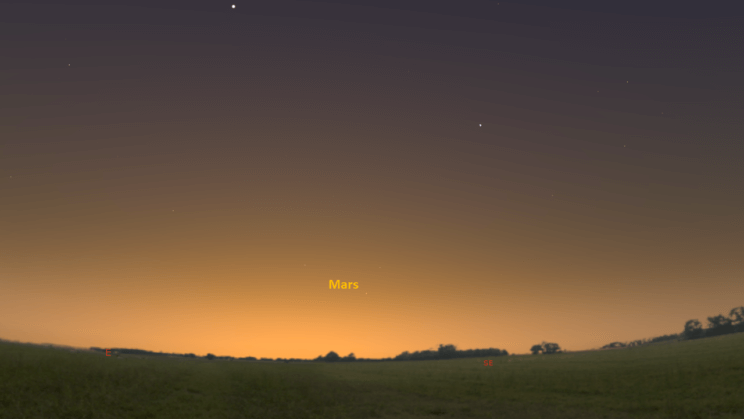This is the Saint Louis Science Center’s NIGHT SKY UPDATE for the week of Friday, November 26, 2021.
Information updated weekly or as needed.
Times given as local St. Louis time which is Central Standard Time (CST). For definitions of terminology used in the night sky update, click the highlighted text. If relying on times posted in Universal Time (UT), St. louis is -6 hours when CST.
Public Telescope Viewings
With the changing recommendations from the CDC regarding COVID-19, conversations regarding the return of star parties at the Saint Louis Science Center have begun. We are close to bringing back our public telescope viewings, but a few details still need to be worked out. We will post future updates as we learn more about when we can bring back telescope viewings.
Observing Highlight of the Week

The Winter Circle seen rising by 11 pm on November 26, 2021. Image created using Stellarium.
With winter less then one month away, now is a good time to learn the asterism known as the Winter Circle. Asterisms are patterns of stars that are not on the list of official 88 constellations established by the International Astronomical Union. Over the years, observers have created a unique asterism for each seasonal sky. The Winter Circle is the largest and in my opinion is the easiest to explore. Right in the middle of the circle is the famed constellation Orion, which serves as a useful way finder for the stars of the circle.
The Winter Circle is made up of 7 bright stars: Aldebaran, Rigel, Sirius, Procyon, Castor, Pollux and Capella. If you connect the dots between these stars, they make a rough circle, or some describe it as a hexagon. Pollux and Castor are in the constellation Gemini, and the rest are in different constellations. Sirius is in Canis Major, Rigel is in Orion, Aldebaran is in Taurus, Capella is in Auriga, and Procyon is in Canis Minor.
To find each of these stars, look for the large X-shape of the constellation Orion. Once you can find this start with his belt. Following the stars of Orion’s Belt east, you will find Sirius. Going west from the belt takes you to Aldebaran. Bottom right to top left of Orion points you to Castor and Pollux. Between Pollux and Sirius is Procyon and Capella is due north of Orion’s head. Finding these stars is how you can identify the constellations they are part of.
Once you have a good feel for the winter sky, the next step is to track down some deep sky objects. If you have binoculars, a good place to start is with star clusters. Good starting star clusters are the Hyades and the Pleiades in Taurus, Collinder 70 in Orion, Messier 36, 37 and 38 in Auriga, and Messier 41 in Canis Major. Also in Orion, you can find the emission nebula Messier 42 under his belt. For those with telescopes, all the above still good choices, but I will add Messier 1 in Taurus as well. This supernova remnant stems from a type II supernova that was seen in 1054 CE.
Another step up in difficulty would be multiple star systems or variable stars. Iota Orionis is a quadruple star system with three visible components. It is also part of the star cluster NGC 1980. Another good multiple star system is Castor in Gemini. This is a 6-star system consisting of three pairs which appear as one star each. If you have a telescope, two of the pairs are easy to resolve but the third can be seen with higher magnifications.
Lastly, on December 13/14, the peak activity of the Geminid meteor shower occurs. The radiant for the Geminids is in the constellation Gemini which will be well above the horizon by 10:00 p.m. that night. The Geminids are caused as debris from asteroid 3200 Phaethon enters Earth’s atmosphere. It has long been discussed how an asteroid could be the source of a meteor shower as they normally do not behave like comets which are the normal source. Recently, it has been found the sodium out gassing could occur as the asteroid gets closer to the Sun. This could be the mechanism responsible for producing the debris that causes the Geminids. Learn more about this discovery at https://www.nasa.gov/feature/jpl/fizzing-sodium-could-explain-asteroid-phaethon-s-cometlike-activity
The Sun and Moon

The Moon as seen from the International Space Station, on July 31, 2011.
Credit: NASA
Sunrise is at 6:55 a.m. on Friday, November 19 and sunset is at 4:41 p.m. providing us with under 10 hours of daylight. Even after sunset, the light from the Sun will dimly illuminate our sky for roughly 1 hour and 30 minutes. This period is called twilight, which ends around 6:15 p.m. this week. For those with a sundial, local noon occurs around 11:48 a.m. this week.
| Day | Sunrise | Sunset |
|---|---|---|
| 2021-11-26 | 6:55 a.m. | 4:41 p.m. |
| 2021-11-27 | 6:56 a.m. | 4:41 p.m. |
| 2021-11-28 | 6:57 a.m. | 4:40 p.m. |
| 2021-11-29 | 6:58 a.m. | 4:40 p.m. |
| 2021-11-30 | 6:59 a.m. | 4:40 p.m. |
| 2021-12-01 | 7:00 a.m. | 4:40 p.m. |
| 2021-12-02 | 7:01 a.m. | 4:40 p.m. |
| 2021-12-03 | 7:02 a.m. | 4:39 p.m. |
| 2021-12-04 | 7:03 a.m. | 4:39 p.m. |
December 4, 2021, Total Solar Eclipse
On December 4, 2021, a total solar eclipse will occur. Unfortunately, none of this eclipse is visible from St. Louis. Totality will only be seen from Antarctica and parts of the Antarctic Ocean. The southern tip of Chile and Argentina, the Falkland Islands, South Africa and parts of Australia and New Zealand will experience minor partial phases of the eclipse. Most view of the eclipse will likely come from airplane or ocean vessel.
This is the 13th eclipse in Saros 152. The first eclipse of this saros started on July 26, 1805, and the last occurs on August 20. 3049. In total, there are 70 solar eclipses that are part of saros 52. Eventually, eclipses in this saros will be visible from North America but that will be a while. You can learn more about Saros 152 here http://eclipsewise.com/solar/SEsaros/SEsaros152.html
Moon
Moonrise for Friday, November 26 occurs at 11:06 p.m. and moonset will occur on the following day ay at 1:06 p.m. On Friday, November 26 the Moon will exhibit a waning gibbous phase with 56% of the lunar disk illuminated. Last quarter moon occurs on November 27, 2021, at 6:28 a.m.
International Space Station (ISS) Observing

Visible passes of ISS from St. Louis for the week of November 19 occur during evening hours. The best passes this week occur on the evenings of December 3 and 4. Use the table below for information about this and other visible passes this week.
Catch ISS from St. Louis starting Friday, November 26
| Date | Starts | Max. altitude | Ends | |||||||
|---|---|---|---|---|---|---|---|---|---|---|
| Time | Alt. | Az. | Time | Alt. | Az. | Time | Alt. | Az. | ||
| 03 Dec | -2.1 | 17:59:35 | 10 | NNW | 18:01:55 | 20 | NNE | 18:01:55 | 20 | NNE |
| 04 Dec | -1.8 | 17:12:35 | 10 | NNW | 17:14:42 | 15 | NNE | 17:16:47 | 10 | ENE |
| 04 Dec | -1.6 | 18:48:36 | 10 | NW | 18:49:56 | 22 | NW | 18:49:56 | 22 | NW |
Magnitude (Mag): The Measure of brightness for a celestial object. The lower the value is, the brighter the object will be.
Altitude (Alt): The angle of a celestial object measured upwards from the observer’s horizon.
Azimuth (Az): The direction of a celestial object, measured clockwise from an observer’s location with north being 0°, east being 90°, south being 180° and west being 270°.
For information about ISS flyovers and other visible satellites, visit www.heavens-above.com
Detailed information regarding all unmanned exploration of our universe, missions past, present, and planned, can be found at Jet Propulsion Laboratories:
The Visible Planets

Looking South, at 6:00 p.m. November 26, 2021. Credit: Stellarium, EG

Looking east, at 6:26 am, November 27, 2021. Credit: Stellarium, EG
This week, three naked eye planets are visible. Venus can be found in the south southwest after sunset. Jupiter and Saturn can be found in the south after sunset. Mars is still tough to see but it is steadily climbing out o the Sun’s glare in the east before sunrise.
Venus
Venus is well into another evening apparition. It will be visible in the southwest as the sun sets. Venus will set at 7:25 p.m. Venus is on its way back towards the Sun’s glare as it approaches inferior conjunction on January 8, 2022.
Mars
A new apparition for Mars has begun. For most of us, Mars will remain elusive unless your southeastern view is clear at the horizon. Currently Mars rises at 5:37 a.m. 30 minutes before sunrise, Mars will only be roughly 8° above the horizon. Mars will continue to climb out of the Sun’s glare as we see the end of 2021. Mars reaches opposition next year on December 7, 2022.
Jupiter
Jupiter has passed opposition and as such will be visible after sunset. Look for Jupiter in the south as it starts to darken outside. Jupiter sets at 10:38 p.m. and will set about 30 minutes earlier each week. Jupiter reaches superior conjunction on March 5, 2022. This means we can count on seeing Jupiter in the southern skies for the rest of this year and well into 2022.
Saturn
Saturn is past opposition which means it will be visible about 20 minutes after sunset. Right now, it can be found in the south after sunset, but as we continue through the year, Saturn will set about 30 minutes earlier each night. Saturn sets at 9:41 p.m. Saturn will reach superior conjunction on February 4, 2022.
James S. McDonnell Planetarium
Night Sky Update: November 26 – December 4, 2021






